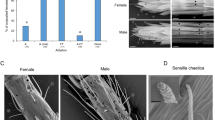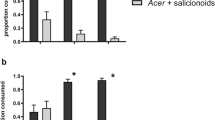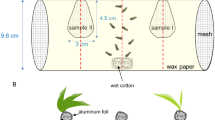Abstract
The sesquiterpene lactone cnicin was extracted fromCentaurea maculosa andCentaurea vallesiaca. We examined its effects on the ovipositional response and larval development of generalist and specialist insect herbivores associated withC. maculosa. For the oviposition trials, three plant species (C. maculosa, Achillea millefolium, andCichorium intybus), half of which were sprayed with 3% of cnicin, were exposed to the specialist mothsStenodes straminea, Agapeta zoegana, andPterolonche inspersa in field cages. All three species significantly preferredC. maculosa to other plants andP. inspersa significantly preferred cnicin-sprayed plants to untreated plants for oviposition. Tested over all species, cnicin significantly increased the number of eggs laid on a given plant. A larval diet test examined the toxicity of cnicin for larvae of the generalist noctuid mothSpodoptera littoralis. Cnicin concentrations of 3% and 6% were lethal and 1% and 0.5% seriously inhibited growth and development. The larvae of theC. maculosa specialistStenodes straminea survived at 6% cnicin, but none of the pupae hatched.Agapeta zoegana was able to survive at 1% and 3% cnicin. Both specialists had difficulties with the artificial diet, but weight increase and survival was not further reduced when cnicin was present compared with on the control diet. In conclusion, cnicin influenced host recognition by the specialist species, and larvae of the generalist did not survive on natural levels of cnicin. Growth and survival of the specialist were not influenced by cnicin but were considerably hampered on artificial diet.
Similar content being viewed by others
References
Bloszyk, E. andDrozdz, B. 1978. Part XXII. Sesquiterpene lactones in species of the genusChrysanthemum.Acta Soc. Bot. Polon. 47 (1–2):3–12.
Burnett, W.C., Jones, S.B., Mabry, T.J., andPadolina, W.G. 1974. Sesquiterpene lactones—insect feeding deterrents inVernonia.Biochem. Syst. Ecol. 2:25–29.
Burnett, W.C., Jones, S.B., andMabry, T.J. 1987. The role of sesqiterpene lactones in plant-animal coevolution.Annu. Proc. Phytochem. Soc. Eur. 15:233–257.
Dunn, P.H., Rosenthall, S.S., Campobasso, G., andTait, S.M. 1989. Host specificity ofPterolonche inspersa (Lep.: Pterolonchidae) and its potential as a biological control agent forCentaurea diffusa, diffuse knapweed, andC. maculosa, spotted knapweed.Entomophaga 34(4):435–446.
Feeny, P. 1976. Plant apparency and chemical defense. Biochemical interactions between plants and insects.Recent Adv. Phytochem. 10:1–40.
Fischer, N.H., Olivier, E.J., andFischer, H.D. 1979. The biogenesis and chemistry of sesquiterpene lactones.Prog. Chem. Org. Nat. Prod. 38:47–390.
Geppert, B., Drozdz, B., Kielczewski, M. andHolub, M. 1983. Sesquiterpene lactones. XXIII. Isolation of sesquiterpene lactones fromCentaurea L. species.Acta Soc. Bot. Polon. 52(1):23–34.
Harmatha, J. andNawrot, J. 1984. Comparison of the feeding deterrent activity of some sesquiterpene lactones and a lignan lactone towards selected insect storage pests.Biochem. Syst. Ecol. 12(1):95–98.
Huneck, S., Jakupovic, J., andSchuster, A. 1986. Weitere Inhaltsstoffe ausCentaurea stoebe.Planta Med. 5:398–399.
Jones, S.B., Burnett, W.C., Coile, N.C., Mabry, T.J., andBetouski, M.F. 1979. Sesqiterpene lactones ofVernonia—influence of glaucolide-A on the growth rate and survival of lepidopterous larvae.Oecologia 39:71–77.
Kelsey, R.G. andLocken, L.J. 1987. Phytotoxic properties of cnicin, a sesquiterpene lactone fromCentaurea maculosa (spotted knapweed).J. Chem. Ecol. 13(1):19–33.
Kery, A., Turiak, G.V., Zambo, I., andTetenyi, P. 1987. Comparison of different separation techniques on the biologically active sesquiterpene lactones.Acta Pharm. Hung. 57:228–238.
Landau, I. 1993. Cnicin, ein Sesquiterpenlacton der gefleckten FlockenblumeCentaurea maculosa: Einfluss auf Spezialisten- und Generalisten-Herbivoren. Diploma thesis. University of Zürich.
Locken, L.J. andKelsey, R.G. 1987. Cnicin concentrations inCentaurea maculosa, spotted knapweed.Biochem. Syst. Ecol. 15(3):313–320.
Mabry, T.J. andGill, J.E. 1979. Sesquiterpene lactones and other terpeniods, pp. 502–537,in G.A. Rosenthal and D.H. Janzen (eds.). Herbivores: Their Interaction with Secondary Plant Metabolites. Academic Press, New York.
Mabry, T.J., Gill, J.E., Burnett, W.C., andJones, S.B. 1977. Antifeedant sesquiterpene lactones in the Compositae, pp. 179–184,in P.A. Hedin (ed.). Host Plants Resistance to Pests. American Chemical Society, Washington.
Muir, A.D. andMajak, W. 1983. Allelopathic potential of diffuse knapweed (Centaurea diffusa) extracts.Can. J. Plant Sci. 63:989–996.
Muir, A.D., Majak, W., Balza, F., andTowers, G.H.N. 1985. A search for the allelopathic agents in diffuse knapweed. A.C.S. Symposium Series 330. Allochemicals: Role in Agriculture and Forestry. American Chemical Society, Washington, D.C.
Müller, H. 1983. Untersuchungen zur Eignung vonStenodes straminea Haw. (Lep: Cochylidae) für die biologische Bekämpfung vonCentaurea maculosa Lam. (Gefleckte Flockenblume) (Compositae) in Kanada.Bull. Soc. Entomol. Suisse 56:329–342.
Müller, H. 1989. Structural analysis of the phytophagous insect guilds associated with the roots ofCentaurea maculosa Lam.,C. diffusa Lam., andC. vallesiaca Jordan in Europe.Oecologia 78:41–52.
Müller, H. andSteinger, T. 1990. Separate and joint effects of root herbivores, plant competition and nitrogen shortage on resource allocation and components of reproduction inCentaurea maculosa (Compositae).Symp. Biol. Hung. 39:215–224.
Müller, H., Schroeder, D., andGassmann, A. 1988.Agapeta zoegana (L.) (Lep: Cochylidae), a suitable prospect for biological control of spotted and diffuse knapweed,Centaurea maculosa Monnet de la Marck andCentaurea diffusa Monnet de la Marck (Compositae) in North America.Can. Entomol. 120:109–124.
Müller-Schärer, H. andSchroeder, D. 1993. The biological control ofCentaurea spp. in North America: Do insects solve the problem?Pestic. Sci. 37:343–353.
Navon, A. 1985.Spodoptera littoralis P. Sigh and R.F. Moore (eds.). Handbook of Insect Rearing, Vol. II. Elsevier, Amsterdam.
Nawrot, J., Smitalova, Z., andHolub, M. 1983. Deterrent activity of sesquiterpene lactones from the Umbelliferae against storage pests.Biochem. Syst. Ecol. 11(3):243–245.
Nowak, G., Drozdz, B., andGeorgiadis, T. 1984. Sesquiterpene lactones. XXIX. Cnicin in species of the subgenusAcrolophus (Cass.)Dobrocz. Acta Soc. Bot. Polon. 53(2):199–205.
Picman, A.K. andPicman, J. 1984. Effect of selected pseudoguaianolides on survival of the flour beetle,Tribolium confusum.Biochem. Syst. Ecol. 12(1):89–93.
Picman, A.K., Elliott, R.H., andTowers, G.H.N. 1978. Insect feeding deterrent property of alantolactone.Biochem. Syst. Ecol. 6:333–335.
Rodriguez, E., Towers, G.H.N., andMitchell, J.C. 1976. Biological activities of sesquiterpene lactones.Phytochemistry 15:1573–1580.
Schroeder, D. 1985. The search for effective biological control agents in Europe. 1. Diffuse and spotted knapweed, pp. 103–119,in E.S. Delfoss (ed.). Proc. 6th Int. Symp. Biol. Contr. Weeds, Vancouver, B.C., Canada, 1984. Agriculture Canada.
Seaman, F.C. 1982. Sesquiterpene lactones as taxonomic characters in the Asteraceae.Bot. Rev. 48(2):121–595.
Sokal, R.R. andRohlf, F.J. 1981. The Principles and Practice of Statistics in Biological Research, 2nd ed. W.H. Freeman, New York.
Author information
Authors and Affiliations
Rights and permissions
About this article
Cite this article
Landau, I., Müller-Schärer, H. & Ward, P.I. Influence of cnicin, a sesquiterpene lactone ofCentaurea maculosa (Asteraceae), on specialist and generalist insect herbivores. J Chem Ecol 20, 929–942 (1994). https://doi.org/10.1007/BF02059588
Received:
Accepted:
Issue Date:
DOI: https://doi.org/10.1007/BF02059588




